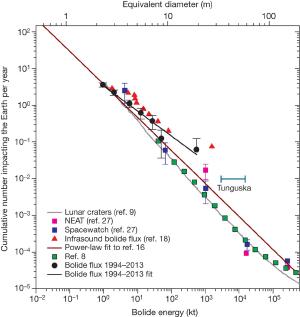Blog
Fire in the Sky
10 November 2013
In February a meteor streaked across the sky near Chelyabinsk, which was caught on video from various angles, much to the delight of news media everywhere. The large amount of video data also meant there was more data on the size and trajectory of the meteor than we usually have. Now a paper in Nature presents an analysis of the Chelyabinsk meteor, as well as some sobering statistics on meteor strikes with Earth.
By analyzing video, infrasound and seismic data, the team estimated the size of the meteor to be about 20 meters in diameter, with an impact energy of about 500 kilotons. This is about 25 – 30 times more energy than was released by the atomic bombs dropped during World War II. Fortunately, the Chelyabinsk meteor came in at a very shallow angle, and exploded about 25 km (15 miles) above the ground, thus limiting its damage. Even from this height there was some serious shock wave damage, including injuries to more than 1,500 people.
By comparison, the famous Tunguska impact of 1908 was about 10 – 15 megatons, or about thirty times larger. It was likely 100 meters wide and detonated 5 – 10 kilometers above the ground. If Tunguska had detonated over a major city it would have wiped it off the map. The Chelyabinsk meteor wasn’t a potential city-killer, but it was moderately powerful.
Usually when we look at the risk of meteor impacts the focus has been on Tunguska-type impacts. That is, potential city killers. Larger meteoroids would cause more regional devastation, but they are also larger and easier to detect. Meteors a few meters wide are much more common and nearly impossible to detect, but are too small to create any serious damage. Now with Chelyabinsk we have a different risk. Moderate local damage from meteoroids tens of meters wide.
One way to look at the odds of an impact is through an estimation of the cumulative number of impacts at a given size. In a typical year, how many 10 cm meteors strike the earth, how many 1 meter in diameter, how many 10 meters wide, etc. You can see the data on this distribution in the figure below (taken from the paper).
 Brown, Peter G., et al.
Brown, Peter G., et al.Meteoroids generally have a power law size distribution. For example, with a power law of 1, for every 100 meter wide meteoroid there would be 10 with a diameter of 10 meters and 100 with a diameter of 1 meter. This is why the figure below uses a log scale. The red line gives the best power law relation from the overall data. From the red line you can see that we would expect a 2 meter impact about once a year, but a 100 meter impact only once in ten thousand years.
In the middle of the graph is a black line, which is a fit to 20 years of observational data on impacts on the order of 10 meters, including Chelyabinsk. As you can see, that line skews higher than the red line for meteoroids on the order of 5 – 20 meters in diameter. That means that there is a higher risk of impacts in that range than expected from the overall red line. In the case of a Chelyabinsk-sized impact, that risk is higher by about a factor of 10.
Just to be clear, the risk of you and yours being injured by a meteor impact is extremely low. But these new results indicate that the risk of Chelyabinsk-size impacts is higher than we’ve assumed. That means we would do well to put more attention on tracking meteoroids of that size. Fortunately we have the technical ability to do that. Whether we have the will is another story.